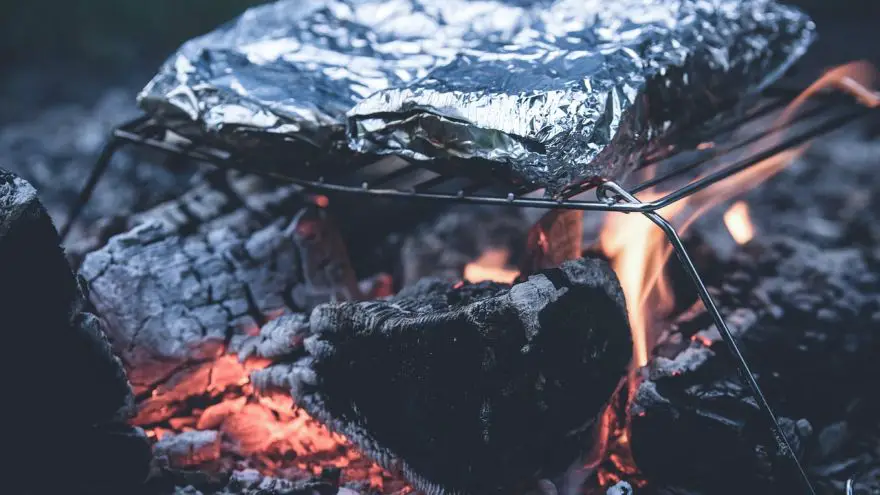Cooking With Foil
 Cooking With Foil
gearweare.net
Cooking With Foil
gearweare.net
Anyone who hangs out at the beach or hikes through the woods has probably tried their hand at cooking over a fire or portable grill. Any why wouldn’t you? The food tastes great and trying out new cooking techniques is all part of the adventure. When planning for your next outdoor excursion, whether it is a multi-day backpacking trip or a journey to the deck at your beach rental, set a goal to cook with foil! Yes, regular old aluminum foil! It is a versatile product that easily lends itself to fire or grill cooking. In fact, one of the fabulous benefits of foil is that it can be used in place of a skillet for just about anything you would normally bake, steam, or fry.
Table of Contents
Advantage of Using Foil to Cook
Aluminum foil is in just about any kitchen in America. We use it to cover foods for storage, keep foods warm after preparation, and yes, for cooking, but have you ever stopped to think about exactly how handy it is? First off, foil is extremely light. Unless you are packing 250 feet of the stuff you will barely even feel the weight of it in your backpack or supply tote. In contrast to heavy skillets, foil is compact too so it doesn’t take up much space after being pressed flat. Cooking with foil offers an easy, not only in packing and transport, but also in serving and clean up. Because foil cools off very quickly you can effortlessly eat directly from the packet without using excess plates or bowls. In addition, foil is disposable so it is simple to wad up and (bonus!) nobody has to fight over who is going to do the dishes.
How to Use it to Cook
As with most materials, there are different qualities of aluminum foil. Thin foil may tear while moving it around the grill or fire pit. If using a heavy-duty foil, one layer is typically enough. If using a thinner variety, you may need to double the layers to secure your food inside the packet. To begin, lay a sheet of foil flat and fill with the ingredients by creating a row down the middle. Leave at least two inches of space around the outside of your food.
When all of your ingredients are laid out, fold in the short sides of the foil. Follow that by folding over the longer sides of the foil. Pull the edges together and fold over a few times so that there are no large gaps. If you find your sheet of foil is not large enough you can add an additional sheet to the top and wrap it around the first piece. Note that without rolling the edges together, your ingredients might try to escape out the side of your packet. Another cooking option with foil is to create an edged skillet and use it to cook foods. This requires a flat and stable surface.
Foil-wrapped foods can be cooked over the open flame of a fire pit with the help of a grate. Some foods even come out great after being wrapped in foil and thrown into the embers of a fire! You can also use the grate on a grill. Once foods are wrapped in foil and placed on or in the heat, remember to flip them frequently so they can cook evenly (with exceptions, see below).
What to Cook in Foil
The easy answer here is to say that you can basically cook anything in foil. Some of the most well known options are baked potatoes and fish. Baked potatoes can be inserted into the hot coals or cooked over a flame. Either way will take around 45 minutes. Fish, after being wrapped with oil or butter and seasoning (fresh herbs are divine!), will take around 20 minutes on a grate. Sliced vegetables of all kinds acquire a fabulous taste when cooked in a foil packet. Corn on the cob is traditionally grilled after removing the silk. To do this, simply pull back the husk and remove the silk inside. Rub the corn with butter and seasonings. At this point you can leave the husk attached or remove it before wrapping the cob in foil. Cook 10-20 minutes.
Pizza is a rare treat while camping or backpacking, but you can get the flavor by creating a calzone or pizza roll. Simply roll or fold your desired ingredients into prepared pizza dough, wrap in foil and cook over a flame or in the embers. Be sure to rotate frequently.
Chicken, shrimp, and ground beef can all be cooked in foil as well. Simply add your desired ingredients, wrap, and cook. When layering other ingredients with raw meat, keep the raw meat at the bottom of the foil so that it can cook in the highest temperatures. For example, you could layer kielbasa, potato and onions/bell peppers. Or, you could layer breakfast sausage or bacon with hash browns, veggies, and cheese. The options are endless!
For dessert, try layering apples, plums, berries, or peaches with dumplings, cobbler crumb, or a pre-made piecrust! An old-time Girl Scout favorite is to cut a long opening through the peel of a banana and stuff with mini marshmallows and chocolate chips. Then enclose in foil and cook over the fire until the entire satchel of goodness is melty. You can even make popcorn over the fire by placing oil and kernels into a disposable pie tin covered with layers of foil (leave room for expansion). For a kettle corn flavor add some sugar to the oil. For variety top with nutritional yeast, chili powder, or Parmesan cheese and enjoy!
A few notes:
*Foods like chicken may appear more steamed than grilled if there is a lot of liquid in the foil and no direct contact with the heat source.
*When observing your distance from the heat, be aware that foods cooked in direct contact of the flame may acquire burnt edges. It’s all part of the experience!











